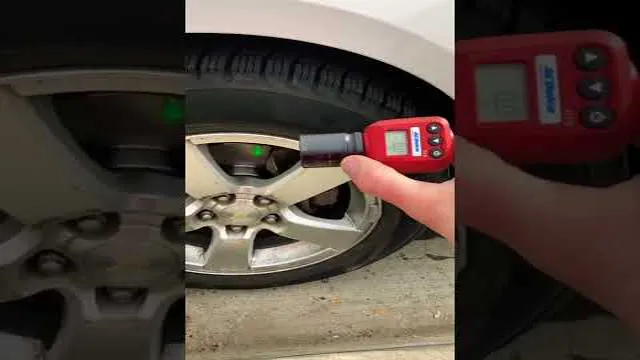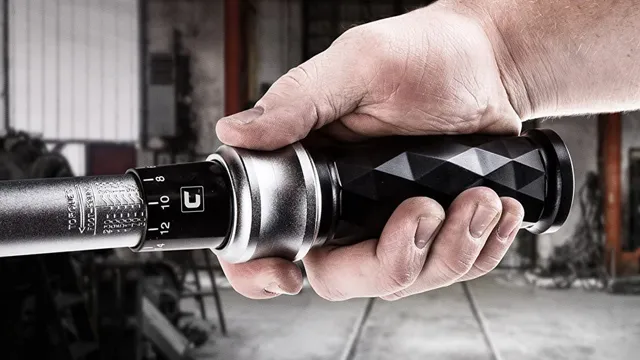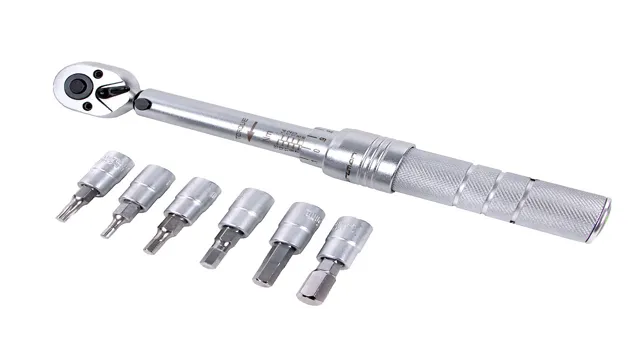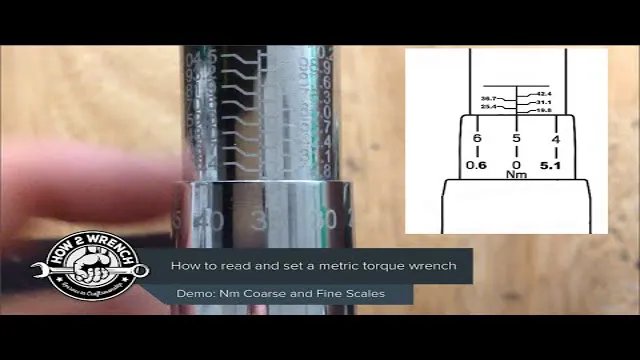Can You Use a Torque Wrench with an Extension? The Ultimate Guide to Preserving Accuracy.

Using a torque wrench with an extension can be both a helpful and daunting task for those not familiar with the tool. While it may seem like an easy addition to a wrench, choosing the right extension and correctly using it can prevent costly mistakes and ensure accurate tightening of bolts. In this blog, we will explore the benefits and challenges of using an extension with a torque wrench.
By the end of this read, you’ll have a better understanding of how to use a torque wrench with an extension like a pro. So, let’s get started!
Understanding Torque Wrenches and Extensions
One common question that arises when it comes to using a torque wrench is whether you can use it with an extension. The answer is yes, you can. However, it’s important to keep in mind that using an extension can impact the accuracy of your torque measurement.
That’s because the longer the extension, the more “give” there is in the tool, which can result in a lower torque being applied than what you intended. To prevent this, you can use a torque extension bar, which allows you to achieve the correct torque reading even when working with an extension. It’s also important to make sure that the extension you use is rated for use with your torque wrench, and that you follow the manufacturer’s instructions carefully to ensure safe and accurate use.
By taking these precautions, you can use your torque wrench with an extension when necessary while still achieving accurate torque measurements every time.
What is a torque wrench?
A torque wrench is a specialized tool designed to apply a specific amount of force, or torque, to a fastener such as a nut or bolt. These wrenches are particularly useful for applications where precise torque is required to ensure the safety and longevity of the machinery or equipment being assembled or serviced. Torque wrenches come in various sizes, shapes, and designs, each with its own specific torque range and application.
Extensions are often used with torque wrenches to reach areas that are difficult or impossible to access with regular wrenches. Extensions are designed to maintain the accuracy of the torque measurement and can be used with various types of torque wrenches, including clicker, beam, and electronic wrenches. Understanding how torque wrenches and extensions work is crucial for anyone working with machinery and equipment.

What is an extension?
An extension is a tool that attaches to a torque wrench to provide additional length for reaching nuts and bolts in hard-to-reach locations. This is especially useful when working on engines or other machinery where space is limited. Extensions come in a variety of lengths and sizes, and it’s important to choose the right one for the job to ensure accuracy and safety.
When using an extension with a torque wrench, it’s important to factor in the length of the extension when setting the torque specifications. This is because the added length can affect the torque value, and failure to account for this can result in inaccuracies and potentially dangerous situations. As with all tools, it’s crucial to use extensions and torque wrenches properly and follow manufacturer guidelines to ensure optimal performance and safety.
How does a torque wrench work?
A torque wrench is a tool used to apply a specific amount of torque to a bolt or nut. It works by utilizing a spring-loaded mechanism that measures the amount of force being applied. The wrench is set to the desired torque, which is typically measured in foot-pounds or Newton-meters, and will click or release once that torque value has been reached.
Torque wrenches are commonly used in automotive and mechanical industries where precise torque is crucial for the proper functioning and safety of equipment. If you are working with a torque wrench, it is important to use the correct size and type of socket to avoid damaging the equipment. Additionally, using a torque extension can help you reach bolts in tight spaces and accurately apply torque to hard-to-reach areas.
Understanding how a torque wrench and extensions work is crucial for anyone in these industries to properly and safely complete their work.
Using an Extension with a Torque Wrench
If you’ve ever found yourself in a situation where you need to use a torque wrench with an extension, you might be wondering if it’s safe to do so. The short answer is yes, you can use a torque wrench with an extension, but there are some important things to keep in mind. First and foremost, you need to make sure that the extension you’re using is the right length for the job at hand.
Using an extension that is too short or too long can throw off your torque readings and lead to inaccurate results. Additionally, you’ll want to make sure that the extension is compatible with your torque wrench and that it’s properly attached before use. By taking the time to ensure that everything is set up properly, you can safely use your torque wrench with an extension and get the job done right.
Can you use an extension with a torque wrench?
Using an extension with a torque wrench can be done, but it’s important to do it correctly. When using an extension, you add extra length to the wrench which can affect the accuracy of the torque reading. To ensure accurate torque readings, it’s crucial to choose the right extension length and use it properly.
Choosing the wrong extension can lead to over or undertightening the bolt or nut. To make sure the extension is used correctly, it’s important to keep the angle between the extension and the handle as small as possible and not to push or pull the extension. The extension should only be used to reach bolts that are hard to reach, and not as a permanent extension for the wrench.
With proper use and understanding, an extension can help get the job done easier and quickly.
When is it necessary to use an extension with a torque wrench?
When using a torque wrench, it’s important to know when and how to use an extension properly. An extension can be a useful tool when you need to tighten bolts or nuts in hard-to-reach areas. However, it’s crucial to remember that using an extension can affect the accuracy of the torque reading.
An extension can add additional leverage, which can lead to over-tightening and inaccurate readings. Generally, if the length of the extension exceeds five times the diameter of the socket, you should use a torque adapter instead. Using an adapter will maintain the accuracy of torque readings while still allowing you to get into tight spaces.
So, it’s essential to be aware of the limitations and proper usage of extensions when using a torque wrench for optimal results.
What are the risks of using an extension with a torque wrench?
Torque wrench. Using an extension with a torque wrench may seem like a good idea to reach difficult-to-access bolts, but it can actually be very risky. Extensions can add length to the torque wrench, which in turn, can affect the torque reading.
This means that the torque applied by the wrench could be significantly different than the desired torque, leading to either under-tightening or over-tightening of the bolt. Additionally, using an extension with a torque wrench can increase the risk of breakage and may compromise the accuracy of the wrench. It’s important to note that not all torque wrenches are designed to be used with extensions, so it’s crucial to check the manufacturer’s recommendations before doing so.
In general, it’s best to avoid using an extension with a torque wrench, or at least use it with caution and ensure accurate readings.
Best Practices for Using a Torque Wrench with an Extension
Using a torque wrench with an extension can be tricky, but it’s definitely possible. However, it’s important to remember that the further you extend the wrench, the less accurate it becomes. To minimize this loss of accuracy, it’s best to use the shortest extension possible.
Ideally, an extension should be no longer than 6 inches. Additionally, it’s important to use a high-quality extension that’s designed for use with torque wrenches. This will help ensure that the tool doesn’t slip or deform under pressure.
Finally, it’s a good idea to calibrate your wrench and extension regularly to ensure that they’re still accurate. With these tips in mind, you can use a torque wrench with an extension safely and effectively.
Choosing the right extension
When it comes to using a torque wrench with an extension, it’s crucial to choose the right one for the job. The best practice is to use the shortest extension possible to limit the amount of torque lost through the extension itself. An extension that’s too long can lead to inaccurate readings and result in dangerous situations.
Additionally, it’s essential to use the correct torque wrench adapter to avoid damaging the tool or the extension. Always remember to use a torque wrench that’s calibrated regularly to ensure accuracy and precision. By following these best practices, you can ensure that your torque wrench and extension are working together to deliver accurate and reliable results.
Maintaining proper torque accuracy
Maintaining proper torque accuracy can be a challenging task, especially when using an extension with your torque wrench. However, following a few best practices can ensure that your torque wrench with an extension produces accurate results every time. It’s essential to choose the right extension for the job, as using an incorrect length or type of extension can lead to inaccurate readings.
Always check the manufacturer’s guidelines for the torque wrench and extension to ensure compatibility and accuracy. Additionally, it’s crucial to use the extension correctly by ensuring that it is properly inserted and seated into the torque wrench and the fastener. Any looseness or misalignment can lead to inaccurate torque readings.
Finally, it’s vital to calibrate your torque wrench regularly to maintain accuracy. Checking your wrench’s calibration against a known torque standard will ensure it is accurately measuring the torque applied to the fastener. By following these best practices, you can ensure your torque wrench with an extension produces reliable and accurate results every time.
Avoiding over-torquing or under-torquing
When using a torque wrench with an extension, it’s important to be aware of the risk of over-torquing or under-torquing the bolts or nuts. To avoid such problems, it’s recommended to use a torque wrench with the appropriate extension length for the specific application. Using a shorter extension can result in under-torquing, while using a longer extension can lead to over-torquing.
It’s also important to ensure that the extension is properly secured to the torque wrench and socket to prevent any errors in torque readings. Remember, a torque wrench is a precision tool that requires proper handling to achieve accurate results. With the right approach and proper understanding, you can ensure that your torque wrench and extension are working together effectively to achieve optimal results.
Performing regular calibration
Performing regular calibration is essential when using a torque wrench with an extension to ensure accurate and consistent results. Best practices include calibrating the torque wrench and extension separately before using them together. When using the extension, make sure it is the correct length for the job, and do not exceed the torque limit of the extension.
It’s also important to check the condition of the extension regularly to avoid any wear or damage that could affect its performance. Additionally, using a torque wrench with an extension requires proper technique, including keeping the extension straight and avoiding applying any sideways forces. By following these best practices and staying on top of regular calibration and maintenance, you can effectively and safely use a torque wrench with an extension for optimum results.
Conclusion and Final Thoughts
In conclusion, using a torque wrench with an extension is a bit like trying to dance with an umbrella; it’s doable, but it’s not exactly recommended. While extensions can allow for greater reach and flexibility, they can also compromise the accuracy and consistency of your torque measurement. So, if you really want to torque things up properly, it’s best to stick with the tried and true method and avoid using extensions whenever possible.
“
FAQs
What is a torque wrench extension?
A torque wrench extension is an attachment that can be used with a torque wrench to increase its reach.
Can I use a torque wrench with an extension?
Yes, you can use a torque wrench with an extension. However, it is important to consider the added length and how it may affect torque accuracy.
How do I choose the right extension for my torque wrench?
To choose the right extension for your torque wrench, you should consider the length and diameter of the extension, as well as its compatibility with your torque wrench model.
What is the maximum extension length I can use with my torque wrench?
The maximum extension length you can use with your torque wrench will depend on the manufacturer’s specifications. It is important to check these specifications before using an extension to ensure accuracy.
Can I use multiple extensions with my torque wrench?
It is generally not recommended to use multiple extensions with a torque wrench as it can cause inaccuracies in the torque readings.
Should I use a straight or angled extension with my torque wrench?
Whether to use a straight or angled extension with a torque wrench will depend on the application. Straight extensions are generally more accurate, while angled extensions are better for hard-to-reach areas.
How do I use a torque wrench extension correctly?
To use a torque wrench extension correctly, make sure it is properly attached to the wrench and the fastener. Use caution when applying torque with the extension, as it can affect accuracy.



